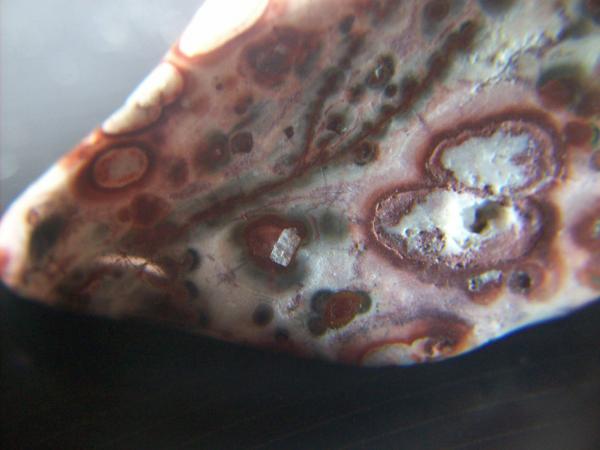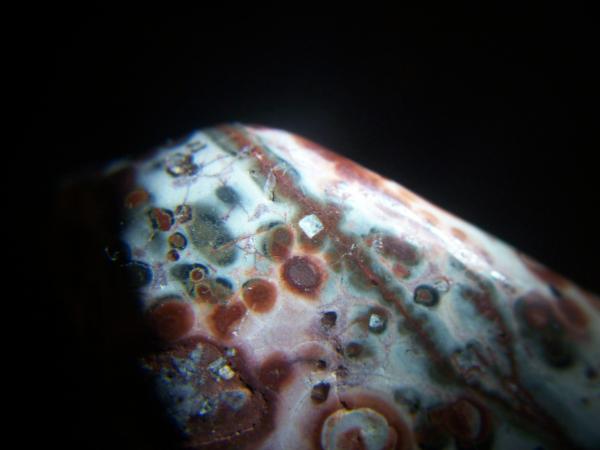| View previous topic :: View next topic |
| Author |
Message |
novicetumbler
Joined: 27 Mar 2010
Posts: 5
Location: California


|
 Posted: Mar 27, 2010 16:41 Post subject: Odd inclusions in an unidentified mineral Posted: Mar 27, 2010 16:41 Post subject: Odd inclusions in an unidentified mineral |
|
|
I just finished running this one stone I found through two tumblers and as I was cleaning it for pre-polish I noticed these extremely odd inclusions. Some are perfectly square, some are perfectly rectangular, none are of odd shape.
I don't know much about minerals in general and identification has always been a bit of a hassle for me. Does anybody perhaps have any clue what this mineral is, and what these inclusions on the matrix might be?
| Description: |
| Another inclusion - off-center lower left, just barely. |
|
| Viewed: |
12922 Time(s) |

|
| Description: |
| A picture of the odd inclusion - barely off-center. Notice the square inclusion in the line. Forgive the fuzzy picture, my ring flash died and I had to do some rigging to get usable lighting. |
|
| Viewed: |
12924 Time(s) |

|
|
|
| Back to top |
|
 |
gemlover

Joined: 31 Dec 2008
Posts: 211
Location: Easley, SC



|
 Posted: Mar 27, 2010 19:51 Post subject: Re: Odd inclusions in an unidentified mineral Posted: Mar 27, 2010 19:51 Post subject: Re: Odd inclusions in an unidentified mineral |
|
|
Cool, i would guess maybe feldspar or calcite; more probably feldspar. but who knows....
john
_________________
John
John Atwell Rasmussen, Ph.D.. AJP
Geologist and Gemologist |
|
| Back to top |
|
 |
novicetumbler
Joined: 27 Mar 2010
Posts: 5
Location: California


|
 Posted: Mar 27, 2010 22:03 Post subject: Re: Odd inclusions in an unidentified mineral Posted: Mar 27, 2010 22:03 Post subject: Re: Odd inclusions in an unidentified mineral |
|
|
| gemlover wrote: | cool, i would guess maybe feldspar or calcite; more probably feldspar. but who knows....
john |
Thank you, I had calcite as my primary guess after taking an exacto knife tip to it and it scratched.
Any ideas what the surrounding stone might be, by chance? If it helps to know location found, it was found in the San Bernardino National Forest, in the stream coming from Forest Falls, just barely into the mountains.
|
|
| Back to top |
|
 |
Pete Modreski
Site Admin

Joined: 30 Jul 2007
Posts: 710
Location: Denver, Colorado



|
 Posted: Mar 29, 2010 14:07 Post subject: Re: Odd inclusions in an unidentified mineral Posted: Mar 29, 2010 14:07 Post subject: Re: Odd inclusions in an unidentified mineral |
|
|
I'm not familiar with that area in CA but just to give this material a general name, I'd say it a type of jasper. (Assuming that it is quite hard, indicating a silicified quartz-rich rock; which I assume it must be, if it polished well in your tumbler.) Since it has a texture of rounded, circular spots, it would be fair to call it an "orbicular jasper", like the well-known greenish "ocean jasper" from Madagascar, or the yellow-red "poppy jasper" from Morgan Hill, Santa Clara County, CA.
Pete
|
|
| Back to top |
|
 |
jacquestouret
Joined: 03 Apr 2007
Posts: 12
Location: Paris


|
 Posted: Mar 30, 2010 10:45 Post subject: Re: Odd inclusions in an unidentified mineral Posted: Mar 30, 2010 10:45 Post subject: Re: Odd inclusions in an unidentified mineral |
|
|
| Pete Modreski wrote: | I'm not familiar with that area in CA but just to give this material a general name, I'd say it a type of jasper. (Assuming that it is quite hard, indicating a silicified quartz-rich rock; which I assume it must be, if it polished well in your tumbler.) Since it has a texture of rounded, circular spots, it would be fair to call it an "orbicular jasper", like the well-known greenish "ocean jasper" from Madagascar, or the yellow-red "poppy jasper" from Morgan Hill, Santa Clara County, CA.
Pete |
I would agree with Pete, my first impression was that this (attractive) rock was some kind of jasper (fits also with the statement that some of the spots are polyhedral, this occurs also in madagascar jasper (shrinkage cooling cracks). What I found interesting in this sample is the greenish spots, apparently older than the reddish ones. Could signify an increasing oxydation during cooling. may be w'll see more examples in the next Tucson show!. Cheers, JT
|
|
| Back to top |
|
 |
alfredo
Site Admin

Joined: 30 Jan 2008
Posts: 1014



|
 Posted: Apr 06, 2010 13:11 Post subject: Re: Odd inclusions in an unidentified mineral Posted: Apr 06, 2010 13:11 Post subject: Re: Odd inclusions in an unidentified mineral |
|
|
| If the jasper was formed by silicification of a volcanic rock (rhyolite, andesite...), then the rectangular inclusions are likely to have been left by feldspar, not calcite. The feldspar may now be partially kaolinized, making it much softer than the surrounding silica.
|
|
| Back to top |
|
 |
|




